|
• Nueva York • West Indian Carnival • Indo-Caribbean New York
• Painting Brooklyn Stories of Immigration and Survival
• Pigeons • Tug Boat Races • Canción de La Magdalena (Song of The Magdalene)
• People’s City Report Card
Dear Citylorists,
Please enjoy our Tours and Tales August, 2010 e-letter!
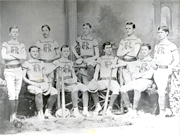 |
Fordham Rose Hill Baseball Club, 1875. Archives and Special Collections, Fordham University Library,
Bronx, New York. |
• Nueva York • On September 17, a landmark exhibit, Nueva York (1613-1945) guest curated by City Lore, opens at El Museo del Barrio, at 5th Avenue and 104th St. This is the first ever exhibition to explore how New York’s long and deep involvement with Spain and Latin America has affected virtually every aspect of the city’s development, from commerce, manufacturing and transportation to communications, entertainment and the arts. If you assumed that the Latino presence in New York began with the Puerto Rican migration after World War II, this exhibit invites you to think again. To create the show, City Lore’s Marci Reaven and Elena Martínez teamed up with Mike Wallace, Distinguished Professor of History at the City University of New York and Pulitzer Prize-winning co-author of Gotham. Organized and cosponsored by New-York Historical Society and El Museo del Barrio, the exhibit spans over three centuries of history, beginning with the Dominican sailor who arrived on our shores in 1613. The exhibit includes an interactive listening station, allowing visitors to sample the Latin music of New York; artworks by modern Latin American artists including José Clemente Orozco and Joaquín Torres-García, reflecting their images of New York; and the Nueva York Theater, an art installation by Antonio Martorell (based on La guaga aérea / The Air Bus, by Luis Rafael Sánchez) showing a documentary that tells the migration stories of Latino New Yorkers after 1945.
 |
Photo by Martha Cooper |
• West Indian Carnival • From September 2-6, the 43rd West Indian carnival dances to life in Brooklyn, with its rollicking steel band panorama, costume celebration and Dimanche Gras, all night J’ouvert parade, and carnival on the Eastern Parkway. Originally Trinidadian, the parade and celebrations now embrace a wide range of Caribbean and African American New Yorkers. You can meet some of the costume makers, revelers, and limbo dancers on our West Indian City of Memory tour.
• Indo-Caribbean New York • Did you know that half of Trinidad’s population is East Indian? Indentured servants from India were brought in great numbers to Trinidad, Guyana, and Suriname, and many immigrated again to the U.S. during the chaotic period when those nations gained their independence. We documented the Indo-Caribbean neighborhood in Richmond Hill, Queens for City of Memory. The tour is led by the beautiful actress and cultural activist — and one of our favorite people — Pritha Singh, along with her brother and historian Karna Singh who run the Rajkumari Cultural Center. Visit the roti shop, the bakery, and follow Pritha as she demonstrates wining, a sexy Indo-Caribbean dance move, and searches for chutney music along Liberty Avenue in Richmond Hill’s Indo-Caribbean neighborhood.
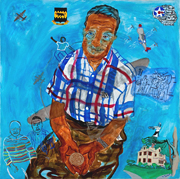 |
Painting by Nina Talbot |
• Painting Brooklyn Stories of Immigration and Survival • A collaboration between painter Nina Talbot and oral historian Rachel Bernstein, Painting Brooklyn Stories of Immigration and Survival opens at the Brooklyn Historical Society on September 17 and runs through February 27, 2011. The opening reception takes place Thursday September 16th, 5:30 - 7:30, and an oral history workshop on Sunday, November 14, 2-4 pm. Gritty stories of Brooklyn residents are told through paintings, oral histories, poetry and personal effects. Meet an Iranian Jew with a jewelry shop in Newkirk Plaza; a Tuskegee Airman originally from the Caribbean whose mother worked as a servant for a family on Rugby Road; a musician from Park Slope whose 96 year old mother remembers arriving in New York from Hangzhou, China in 1938; a Pakistani Muslim woman living in West Midwood; and a woman in Borough Park who survived the Mauthausen concentration camp. A number of these individuals will attend and speak at the opening reception. Our featured story on City of Memory, told by participant Evelyn Loftin, tells of gentrification in Fort Greene.
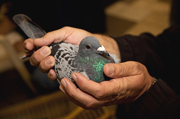 |
Photo by Mathew Connors |
• Pigeons • When I first moved to New York, I arrived via the Brooklyn Queens expressway with no idea that the pigeons circling in flocks overhead were not strays but part of an elaborate tradition of raising and competing with birds on flat NYC rooftops. Most of our work with this tradition through the years has focused on pigeon wars in which flyers send their flocks to mix and attract enemy birds to their own rooftops. "The Pigeon Game," however, is a new documentary work-in-progress about the disappearing culture of homing pigeon racing in New York City. Unknown to most people, there are still men and women who raise birds on their rooftops and race them from distances up to 600 miles. The scenes of Marlon Brando at his pigeon loft in "On the Waterfront" may have secured the sport in the history of the city, but "The Pigeon Game" proves that the tradition still exists today among a small but dedicated group of fliers. City Lore is cosponsoring the free screening on Wednesday, September 1 at 6:30 pm at the Tenement Museum bookstore at 108 Orchard Street.
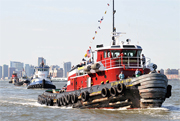 |
|
• Tug Boat Races • Just this week, my wife, folklorist Amanda Dargan and I took one of the wonderful behind-the-scenes Hidden Harbor tours. Although the trip takes place on a Circle Line tour boat, the journey was hosted by Captain John Doswell, and included guest speakers who took us to parts of the Harbor, the Erie Basin, and under the Bayonne Bridge to the container ports of Newark, transforming the way we see the New York City waterfront (see web site for future tours). On September 5th from 9:30 am to 11:30 am the same folks will bring a tug boat jamboree. The event takes place at Pier 84 in the North River, just south of the Intrepid’s Pier 86, and includes tug boat races, on-pier line toss, knot tying, and a spinach eating contest. The event is free, but the best viewing is from the Tug Race Spectator Boat for $30.
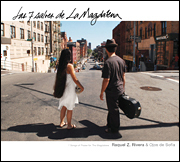 |
|
• Canción de La Magdalena (Song of The Magdalene) • Was Mary Magdalene simply a redeemed prostitute, or much more? On September 10 at 7:00 pm a free CD launch party featuring live music by Raquel Z. Rivera & Ojos de Sofia and an art exhibit by Tanya Torres will take place at at St. Mark’s Church (2nd Avenue & 10th Street). The project explores the biblical/mythical figure of Mary Magdalene, providing multiple alternatives to her most common portrayal as a redeemed prostitute. Canción de La Magdalena features local NYC musicians using the traditional music of Puerto Rico and the Dominican Republic to accompany Raquel Rivera’s lyrics.
• People’s City Report Card • Most New Yorkers, and even the tourists, know that the heart of New York is not at the Met or Lincoln Center but in the hurly burly, the hustle and bustle, the cacophonous mix of ethnic groups, social classes and the arts that makes this city rock. Increasingly, we are aware of an erosion of many of the things we love about this city. At a time when the Mayor and Chancellor Klein are hell bent on testing students, we thought that perhaps it’s time to grade the city on what is being done to preserve the grassroots creativity that makes this city unique, endlessly interesting, forever replenished by the immigrant tides, and the diverse accents, foods and cultural practices they bring.
Clearly the health of the city’s communities is tied to issues of housing and public transportation — and neither of those seems to be getting any easier for most New Yorkers these days. Bike lanes help. But there are other issues in City Lore’s bailiwick. We are looking at the ways in which every New Yorker, including working class people who have not been lucky enough to strike it rich, can express themselves and find their little bit of paradise without having to move to Jersey. We’ve advocated for street performers and places that matter over the years, but there are other arenas — street vendors, community gardens, open markets — with equally passionate advocates. Evaluating each of them side by side can give us a larger view of how the well the city is doing by its grassroots communities. Since we don’t have the resources to fully document and survey these arenas, we will refrain from giving grades, or even pass fail, but set forth some of our observations in ten arenas that, taken together, speak to the grassroots health and well being of our beloved New York.
PRAISEWORTHY
1. Religious Tolerance and Respect. We applaud Mayor Bloomberg for taking a courageous stand on the Islamic Center at Ground Zero. In an August 3rd address he states, " ... we would be untrue to the best part of ourselves — and who we are as New Yorkers and Americans — if we said ‘no’ to a mosque in Lower Manhattan." This year, the NYC City Council also passed a resolution adding Eid Ul-Adha, which marks the end of the annual pilgrimage to Mecca, and Eid Ul-Fitr, which marks the end of Ramadan, as official school holidays, along with the Christian and Jewish holidays.
2. Open Markets. According to foodways consultant Makale Faber, GROW NYC, a city agency, has done commendable work opening new markets and expanding existing ones. She mentioned that many more of the City’s markets are doing well according to the "protein factor," which suggests that markets are stable when you start to see meat, fish and cheese sold in them.
TROUBLING
3. Community Gardens. NYC Community Gardens Coalition is campaigning against a new set of rules for community gardens across the five boroughs eliminating language that protects them and making it easier for the gardens to be sold to developers. You can watch the recent hearing on the proposed rules here.
4. Arts in the Schools. For many low and middle income New Yorkers access to the arts begins in the schools. Reorganization of the Department of Ed eliminated Project Arts which guaranteed that a certain amount of funds for the schools would be spent on arts education. The City now gives principals discretion on how to spend their funds, and rates them principally on their schools’ math and English test scores. This change along with budget cuts, has decimated arts education in the schools.
5. Drumming Circles and Ethnic Celebrations in the Parks. As a result of a brawl in the park, unrelated to the drumming, the wonderful weekly Haitian drumming circle in Prospect Park on Sundays has been shut down indefinitely by the police.
MIXED
6. Street Performers. My fellow advocates, Susie Tanenbaum, Theo Eastwind and I were pleased that the new Chief of Transit Police Ray Diaz allowed us to address the transit police commanders, and that he is sympathetic to street performers rights. However, we are still receiving about a call a week from performers who have been thrown out of Washington Square, Union Square, and Times Square. Sketch artists have also been banned from their long-standing site near the zoo in Central Park.
7. Street Vendors. A conversation with Sean Basinski, director of the Street Vendor Project run by the Urban Justice Center, revealed that a few years ago the city increased fines for vendors operating in the wrong places from $250 to $1,000. On the other hand, Mayor Bloomberg and British Prime Minister David Cameron did share a hot dog from a stand outside of Madison Square Garden recently, and the city is now offering permits for fresh fruits and vegetables to be sold in a number of additional neighborhoods.
8. Street Parades. Robert De Vito who outfits most of the city’s parade floats at Bond Parade Floats in Clifton, NJ (and was the subject of an exhibit by City Lore) said that parades are still thriving in New York, though with fewer floats as a result of the economy. But he also pointed me towards a series of articles about the recent city crackdown on parades. As Andy Newman writes in the Times, "Everyone may love a parade, but ... the department notified parade organizers throughout the city on Monday that starting April 1, their processions must cover 25 percent less distance and may no longer exceed five hours in duration."
9. Places that Matter. Coney is such an important release valve for NYC that it deserves a category of its own. Our friends at Save Coney Island are thrilled that the New York State Historic Preservation Office has declared Coney Island’s amusement district eligible for listing in the State and National Registers of Historic Places. While this does not protect the buildings within the district from demolition, inclusion on the Registers could offer financial incentives for redevelopment projects that rehabilitate and reuse historic properties in the amusement area. The new Luna Park, on land the City bought back from Thor Equities, is a wonderful new addition for Coney this summer. However, Thor appears to have begun demolition work on Coney Island’s historic Henderson Music Hall on Surf Avenue, where Harpo Marx made his stage debut with his brothers Groucho and Gummo, one of the few remnants of historic Coney.
10. Ethnic Social Clubs. No news is good news.
In New York City, the Bloomberg administration, overall, has improved on the record of Giuliani administration for supporting the City’s grassroots cultural life. Nonetheless, the city seems intent on creating an upscale, tourist-friendly city without recognizing that street parades and performers, street vendors, sketch artists, and places like historic Coney Island are part of what attracts visitors, makes the city distinctive — and liveable; they forget, the magic is in the mix.
Please forward this email to your friends and encourage them to join the City Lore’s email list!
Enjoy the City!

City of Memory is sponsored by City Lore and Local Projects. It was funded by The Rockefeller Foundation and the National Endowment for the Arts.
City Lore is part of a cultural coalition called CATCH, to promote the City’s cultural heritage. Check out the web sites of our wonderful partners, the Center for Traditional Music and Dance, the Latino Children’s Theater, SEA, and the World Music Institute.
|
